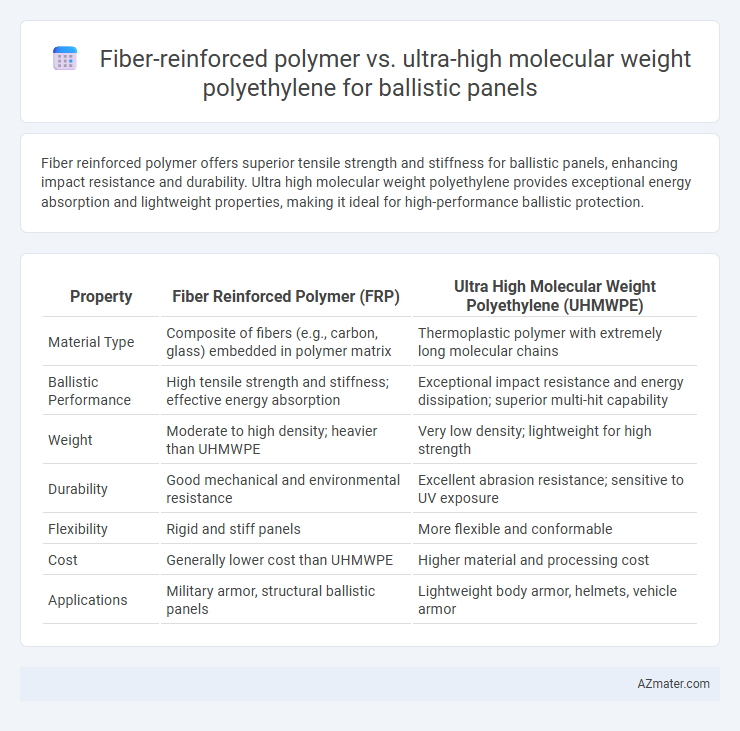Fiber reinforced polymer offers superior tensile strength and stiffness for ballistic panels, enhancing impact resistance and durability. Ultra high molecular weight polyethylene provides exceptional energy absorption and lightweight properties, making it ideal for high-performance ballistic protection.
Table of Comparison
| Property | Fiber Reinforced Polymer (FRP) | Ultra High Molecular Weight Polyethylene (UHMWPE) |
|---|---|---|
| Material Type | Composite of fibers (e.g., carbon, glass) embedded in polymer matrix | Thermoplastic polymer with extremely long molecular chains |
| Ballistic Performance | High tensile strength and stiffness; effective energy absorption | Exceptional impact resistance and energy dissipation; superior multi-hit capability |
| Weight | Moderate to high density; heavier than UHMWPE | Very low density; lightweight for high strength |
| Durability | Good mechanical and environmental resistance | Excellent abrasion resistance; sensitive to UV exposure |
| Flexibility | Rigid and stiff panels | More flexible and conformable |
| Cost | Generally lower cost than UHMWPE | Higher material and processing cost |
| Applications | Military armor, structural ballistic panels | Lightweight body armor, helmets, vehicle armor |
Introduction to Ballistic Panel Materials
Fiber reinforced polymers (FRPs) exhibit superior tensile strength and rigidity, making them ideal for ballistic panels requiring high impact resistance and lightweight properties. Ultra high molecular weight polyethylene (UHMWPE) offers exceptional toughness and energy absorption with a lower density, enhancing flexibility and wear resistance in ballistic protection. Combining FRPs and UHMWPE materials in ballistic panels optimizes durability, weight, and multi-hit performance for advanced personal and vehicle armor systems.
Overview of Fiber Reinforced Polymer (FRP)
Fiber Reinforced Polymer (FRP) is widely utilized in ballistic panels due to its exceptional strength-to-weight ratio and resistance to impact and ballistic threats. Composed of high-strength fibers like glass or carbon embedded in a polymer matrix, FRP offers enhanced durability, flexibility, and energy absorption compared to traditional materials. Its ability to provide reliable protection while maintaining lightweight properties makes FRP a preferred choice in ballistic armor and defense applications.
Understanding Ultra High Molecular Weight Polyethylene (UHMWPE)
Ultra High Molecular Weight Polyethylene (UHMWPE) offers exceptional ballistic performance due to its high tensile strength-to-weight ratio and impact resistance, making it a prime choice for lightweight ballistic panels. Unlike fiber reinforced polymer composites, UHMWPE is inherently flexible and provides superior energy absorption by dispersing impact forces across its molecular chains. Its chemical inertness and low moisture absorption further enhance durability in demanding ballistic protection applications.
Material Properties Comparison: FRP vs. UHMWPE
Fiber reinforced polymer (FRP) exhibits high tensile strength and stiffness due to its composite matrix of fibers embedded in a polymer resin, providing excellent impact resistance and structural rigidity for ballistic panels. Ultra high molecular weight polyethylene (UHMWPE) offers superior energy absorption and tensile strength with exceptional lightweight qualities and chemical resistance, making it ideal for flexible ballistic protection. While FRP delivers robust structural support and durability, UHMWPE excels in lightweight performance and multi-hit ballistic resistance, influencing material selection based on specific threat levels and operational conditions.
Ballistic Performance Analysis
Fiber reinforced polymer (FRP) exhibits superior ballistic performance characterized by high tensile strength and energy absorption, making it effective against high-velocity projectiles. Ultra high molecular weight polyethylene (UHMWPE) offers exceptional impact resistance and lightweight properties, enabling rapid energy dispersion and reduced blunt force trauma. Comparative ballistic testing shows FRP panels excel in multi-hit scenarios, while UHMWPE provides enhanced flexibility and comfort in personal armor applications.
Weight and Thickness Considerations
Fiber reinforced polymer (FRP) ballistic panels typically offer a favorable strength-to-weight ratio but tend to be thicker compared to ultra high molecular weight polyethylene (UHMWPE) panels. UHMWPE panels provide superior lightweight performance with significantly reduced thickness, enhancing mobility without compromising ballistic protection. The density of UHMWPE, approximately 0.93 g/cm3, is considerably lower than most FRP composites, making it an optimal choice where minimizing weight and bulk is critical.
Durability and Environmental Resistance
Fiber reinforced polymer (FRP) ballistic panels exhibit exceptional durability due to their high tensile strength and resistance to impact, maintaining structural integrity under extreme conditions. Ultra high molecular weight polyethylene (UHMWPE) panels offer superior environmental resistance, particularly against moisture, UV radiation, and chemical exposure, ensuring long-term performance in harsh environments. While FRP provides strong mechanical durability, UHMWPE excels in resisting degradation from environmental factors, making the choice dependent on specific operational demands.
Cost and Manufacturing Differences
Fiber reinforced polymer (FRP) ballistic panels generally offer a balance of moderate cost and versatility in manufacturing due to established molding and lamination techniques, making them suitable for large-scale production. Ultra high molecular weight polyethylene (UHMWPE) panels tend to have higher raw material costs but benefit from lightweight properties and simpler thermoforming processes that reduce labor intensity. Cost differences arise mainly from raw material expenses and specific fabrication methods, with FRP favoring traditional composite manufacturing lines and UHMWPE requiring specialized equipment for polymer consolidation.
Application Suitability: Choosing the Right Material
Fiber reinforced polymer (FRP) offers superior stiffness and impact resistance, making it ideal for ballistic panels in vehicle armor and structural protective gear requiring high rigidity. Ultra high molecular weight polyethylene (UHMWPE) provides exceptional energy absorption with lightweight properties, suited for personal body armor and flexible ballistic inserts. Selecting the right material depends on balancing weight, flexibility, and required ballistic protection level specific to the intended application.
Future Trends in Ballistic Panel Technologies
Fiber reinforced polymer (FRP) and ultra high molecular weight polyethylene (UHMWPE) are leading materials in ballistic panel technologies due to their lightweight and high-strength properties. Future trends emphasize enhancing multi-layered composite structures combining FRP and UHMWPE to improve energy absorption, flexibility, and thermal stability in ballistic protection. Innovations also focus on integrating nanomaterials and advanced resin systems to optimize durability and reduce the overall panel thickness while maintaining superior ballistic resistance.

Infographic: Fiber reinforced polymer vs Ultra high molecular weight polyethylene for Ballistic panel
 azmater.com
azmater.com